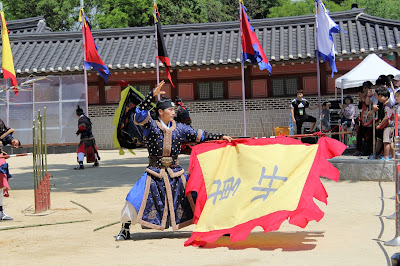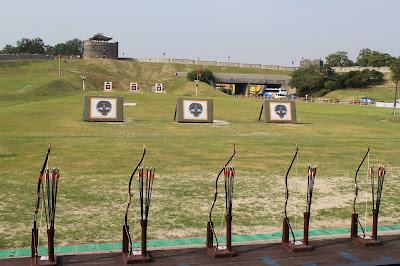If you are a real travel lover, you can hardly miss the smile of the people who lives in those lovely
destinations. Real beauty of some tourist attractions comes from not only the
left relics of the past but the people live in those places, as I think . In
the view of this aspect, maybe the Suwon Hwaseong(수원화성) and the Hwaseong Haenggung(화성행궁),
located at the foot of Paldalsan mountain(팔달산) of
Suwon(수원) next Seoul are the just very places where totally fit
close to that meaning. This Fortress was designated to UNESCO World Heritage in
1997. They highly estimated it as a highlight of oriental fortress.
 |
| Paldalmun gate(south gate),national treasure |
 |
| A scale model for Hwaseong fortress and temporary palace in front of Janganmun Gate |
It has excellent
designs of the fortress architecture which shows the merits of both the eastern
and the western construction methods. Also it had well equipped various
components having scientific merits as an impregnable fort perfectly. Most
parts of this wall and palace over the course of many years were severely
destroyed and damaged, especially under the Japanese colonial period and Korean
War(in 1950-1953). Now days all parts are well maintained through the best
efforts for it and the whole circuit can be walked easily as a wonderful trail
course taking around three hours.
The Great
King Jeongjo(정조대왕)
King Jeongjo was one of two
greatest monarchs, together with the Great King Sejong who invented Korean language, through
all time of the Joseon Dynasty. The King Jeongjo who was the 22nd
King ascended the throne at the age of 25 years
old ,in the Late of Joseon dynasty,in 1776 when the United States got the independence. There is no objection to pick the one of the most outstanding achievements must be the construction of Suwon Hwaseong fortress and the city as an ideal city putting in his dream.
 |
The portrait of King Jeongjo
I thought he is very
handsome and majestic when I saw his portrait at the shrine Woonhangak(운한각) in the Hwaryeongjeon(화령전). What a very
high spirits he was! The simplicity of this shrine non-colored wooden building despite of being palace seems like to show his self-confidence and non-formality. |
 |
| The Woonhangak, a shrine housing the portrait of King Jeongjo |
In fact, it was not easy for him to be a king because his
father, Crown Prince Sado, was killed in the wooden rice chest by his own
father King Yeongjo(21st King) on the charge of conspiracy unfairly.
And thus, It was natural that there were many checks several times by the
political party which took part in his father’s death and scared revenge of his
little son (King Jeongjo, the little son, was just eleven years old and even begged to his
grandfather for his father’s live). There was even an assassination plot against
him. His greatness is merely in the forgiveness to them only. Through his
reign, he opened the offices to the young talented persons according to their ability
regardless of their humble origins or factions. He was the real monarch who
loved the people deeply and put his policies into practice strongly in the part
of national security, defense, economy and commerce.
The Suwon
Hwaseong Fortress(수원화성)
It had been weighed on King
Jeongjo’s mind at all time that his father’s tomb had been in a state of total
neglect for long time. Finally, he relocated it at Hwasan mountain, named it as
Hyeollyungwon (renamed into Yungneung;융릉) and
visited the royal tomb 13 times. According to the official and non-official
records, he missed his father with weeping eyes and hearts, was afflicted at
the fact that his grandfather chose him instead of his father as the next king,
as a result to bring in his father’s death. And then Fortress and palace had
been begun to build in Jan 1794 and completed in Sep 1796 (surprisingly within
three years less) next the father’s tomb.
 |
| The Hwaseomun gate(화서문, west gate) |

Fort is the wall surrounding the
center of Suwon city, stretching to 5.4kms long in length and reaching up from four
to six meters (13-20 ft) high in tall, and Haenggung is the temporary palace
within the walls of Hwaseong Fortress to house for King Jeongjo when visited and paid his respected at his father’s tomb. As he paid correct wage to workers according
the principle of market economy, compared with the past that government work
had been carried out by corvee labour, the construction period was able to be
short to 33 months from 10 years being expected. Of course, new various creative
tools such as crane (Nongno, Geojunggi) used for construction.
 |
| Nongno ; a narrow kind of crane in the front of Suwon Hwaseong Museum |
 |
Geojunggi ; a kind of crane in front of Suwon Hwaseong Museum
He granted
tablet to worker in summer and woolly hat and padded clothes in winter during
construction period. It was big mercy when looked back the social aspect at the
time. The Hwaseong Seongyeok Uigwe(화성성역의궤), the 10 volumes for records of Hwaseong Fortress construction, shows
another highlight of archival culture in detail, well organized records and the king's rational thought.. |
 |
| HwaseongSeongyeokUigwe(화성성역의궤) in the Suwon Hwaseong Museum |
I was
very surprised at the beauty of this fortress and proud of it as walking along
the wall. It was so beautiful that it was unbelievable for me that it was a kind
of military facilities. The wall has four national treasures, four main gates
on each direction, gun towers, observation towers, pavilions, sentry posts,
turrets, crossbow platforms, command posts, beacon tower, secret gates and so
on.
 |
| The Banghwasuryujeong (방화수류정) ; second battle command post |
 |
| The pond viewed from The Banghwasuryujeong( above point) |
 |
The Bongdon(봉돈 ; beacon tower) It is located intentionally in direct line with palace
so that the king could see the signals |
The Hwaseong
Haenggung(화성행궁) temporary palace and the New city(Suwon) surrounded by the fortress
Haenggung is the temporary
palace within the Hwaseong fortress. Originally this was a small local government office till relocation
of Crown Prince Sado tomb. After relocating the tomb, this was expanded up to
600 components scale and became the largest temporary palace in Joseon Dynasty.
It had approximately rectangular layout like as primary palace in Seoul, situated at the
eastern foot of Paldalsan mountain(팔달산).
 |
| Sinpungnu (신풍루) ; the main gate of Hwaseong Haenggung |
The
60th birthday party of King Jeongjo’s mother (Princess Hyegyeong
Hong), national exams, feast for the senior citizens were held in this palace
during the huge royal tomb visitation of eight days in 1795. To be sad most part of this
palace was destroyed under Japanese colonial period and rebuilt again reopen in
2003. Some part of it still has been restored. The painting of the rear
component of it described the big parade in 1795 (Also we could find out in the
Cheonggye stream(청계천) wall in Seoul).
 |
| The palanquin carrying Hyegyeonggung Hong(mother of King Jeongjo) |
 |
The horse carrying King Jeongjo
In accordance with conventions, the King is not actually depicted in the painting
but has been left blank |
6000 peoples and 1400 horses were mobilized in
this big visitation to a tomb according to the official record. It was painted
by the professional artists of an administrative office. Optimistic and funny
expression shown in it seems like to reflect of liberal social mood in his era. This palace and inner area of wall were composed on the vast flatland
and had defensive military function as well as commercial roles in practical
side. He designed the city as a new multipurpose experimental revolution one for promoting
of agriculture and commerce.
 |
| The square in front of palace |
This was a major transportation hub reaching three
local provinces. He took many new attempts when composed this city. For
example, he let the flooded stream changed into reservoir and supplied the
water to the near national farmland. Many floating people and poor military
families engaged in the agriculture and shared the profit on a fifty-fifty
basis between government and actual peasant. So he could enough provide the
expenses of his royal military troop and maintenance finance of fortress and
palace with this profit. He lent money to the local merchants without interest
for three years for promoting the business. Big traditional markets composed at
that time at the right side of Paldalmun gate(
팔달문) are continues
even now. These markets situated on the both side of Suwoncheon stream(수원천) are so enormous. At a short time, I was about to made an impulse buy
by the glittering goods what tempted me. Here was not just the passing by city
when he visited his father’s royal tomb but the starting spot of great turning
point to carry out his ideal. He wanted to expand to many other cities at the
same way after succeeding this modeling city. He wanted to stay with his mother
at this city after succeeding to a throne to his sun (23rd King
Sunjo).
However it did not come true sadly because he died suddenly in 1800 at the
age of just 49 years old by disease. Many planned projects would not be able to
go ahead anymore. Many historians used to say that if he lived 10 years longer
at least, Korea might be much better than as it is.
 |
The Honghwamun gate and The Banghwasuryujeong
I can’t help loving this
city. I had been the program of ‘Walking in the moonlight at Suwon Hwaseong
Haenggung’. It will be another romantic experience at night for me to the past. I’ll
post about it soon.
Tip ; You need three hours at least to take a walk around just the fortress. It
means the more times should be taken to see the palace also. Don’t hurry. Take
your time slowly in here, please!!!. And prepare some drinks, wear comfortable
shoes and something to shield the strong sunshine in case of hot day. Check the
performance schedules carefully through their web site because they have
regular/irregular one.
*****Don't miss my consecutive second and third post >>>
http://goo.gl/EMocei
http://goo.gl/wYVYmI
|

























































